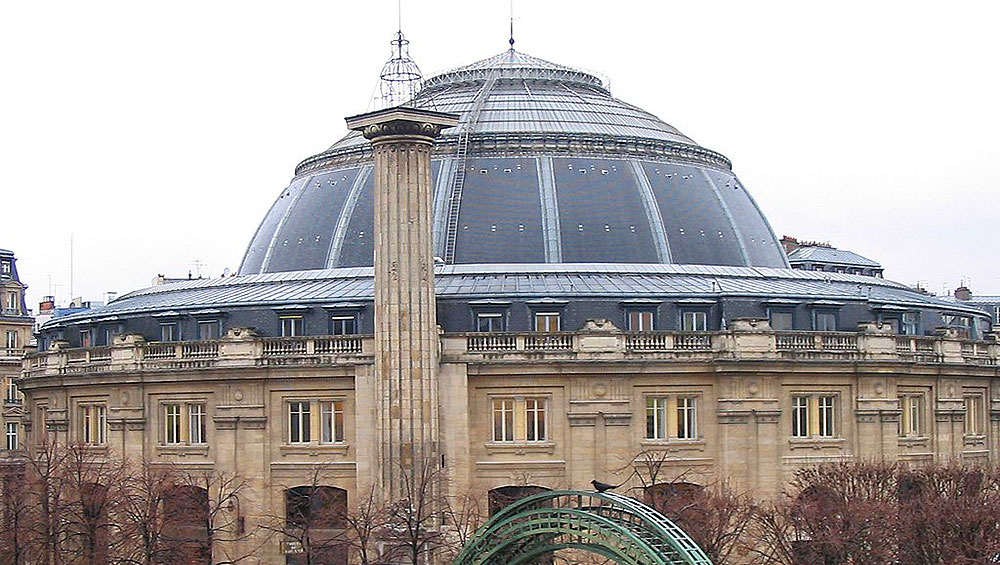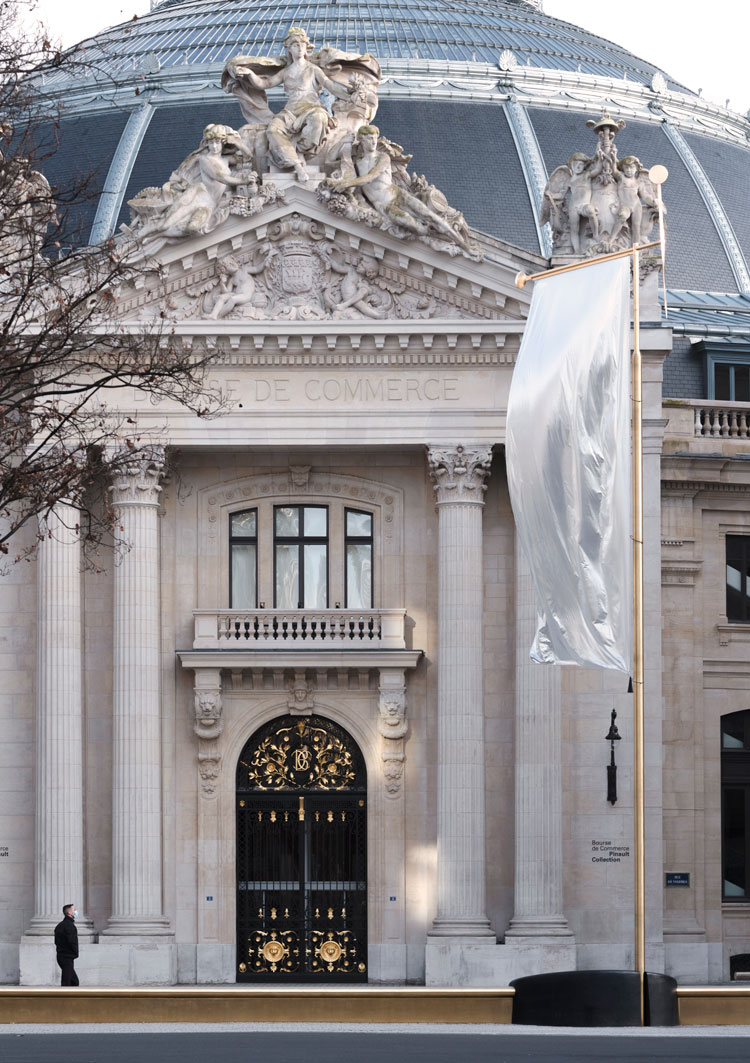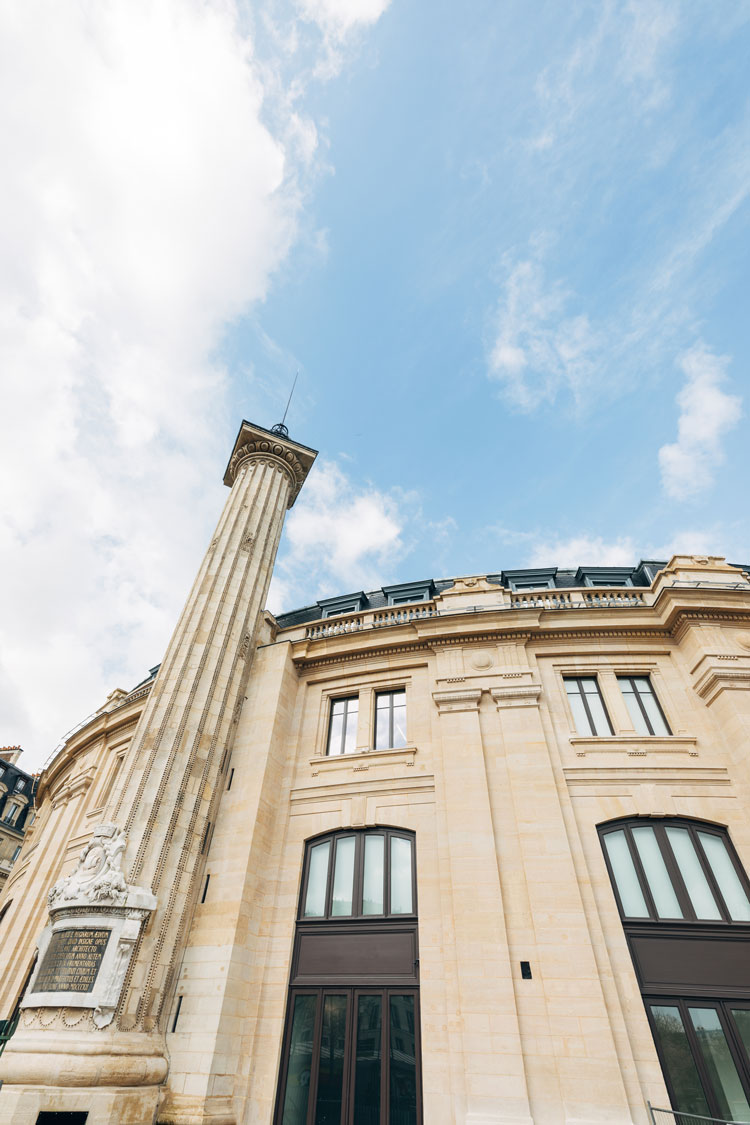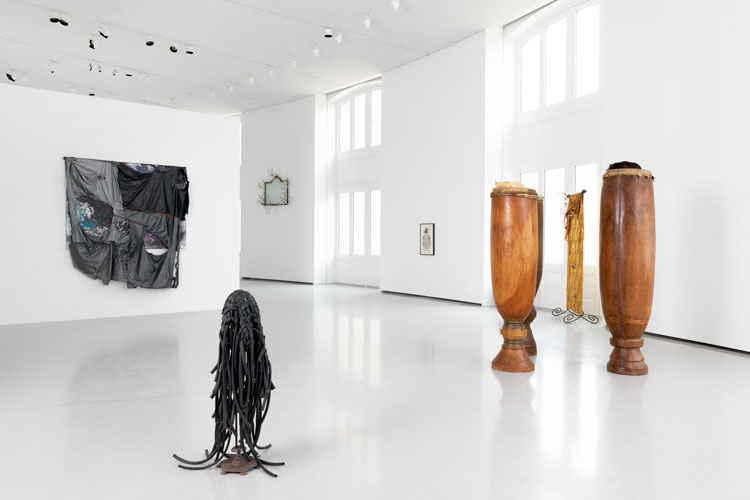
Bourse de Commerce (The metal and glass dome was installed in 1812 and renovated by Tadao Ando Architect & Associates, Niney and Marca Architects, Agency Pierre-Antoine Gatier), Paris. Photo: Indefini, Public domain, via Wikimedia Commons.
by VICTORIA NEWHOUSE
The 18th-century Bourse de Commerce, a domed circular building in the centre of Paris, is particularly suitable for its new inhabitant, the Pinault Collection. While many buildings – from palaces to abandoned factories – have been repurposed for the exhibition of art, this former commodities market melds form and function: a setting designed originally for commerce adapted to today’s art-market commoditisation.
The rotund mass dominates nearby views: it terminates the Rue du Colonel Driant, looms over the many nearby streets and walkways and a large public garden. The shape of the building calls to mind a baroque version of Frank Lloyd Wright’s Guggenheim Museum. But the Bourse is distinguished by a majestic entrance portico flanked by fluted Corinthian columns. The same Corinthian motif appears in regularly spaced pilasters around the building.

Bourse de Commerce (Majestic entrance portico), December 2020. © Studio Bouroullec. Courtesy Bourse de Commerce – Pinault Collection. Photo: Studio Bouroullec.
Atop the giant columns is a pediment crowned by three allegorical figures sculpted by Aristide Croisy: a crown symbolising the City of Paris’s coat of arms sits within the tympanum, while Trade and Abundance perch above the cornice. Inside the skylit rotunda, references to commerce appear in frescoes depicting the history of global trade.
The Bourse de Commerce was part of the city’s centuries-old food market, Les Halles. In the 18th century, it was used for the purchase of wheat; in the 19th century, it became a commodities exchange; and in 1998, it ceased commercial activities. Les Halles was removed from its central location in 1969, initiating a massive renovation of Paris’s right bank. Among the undertakings in the 2004 overhaul of the Bourse neighbourhood were the restoration of the elegant 16th-century church of Saint-Eustache, the creation of the distinctive glazed canopy sheltering the underground shopping mall and its mammoth transportation hub, and the Nelson Mandela Garden. The renewal continues at present with the area’s transformation into a pedestrian zone.
.jpg)
Bourse de Commerce (Frescos within the skylit rotunda depict the history of global trade) – Pinault Collection. © Tadao Ando Architect & Associates, Niney and Marca Architects, Agency Pierre-Antoine Gatier. Photo: Maxime Tétard, Studio Les Graphiquants, Paris.
As this ambitious urban project was taking place, François Pinault, the billionaire businessman, philanthropist and art collector, was looking for a space in Paris where he could display his art collection. At the time, he had in mind the site of a former Renault car plant on an island in the Seine. But city officials couldn’t bring themselves to endorse a private museum for Pinault, and years of wrangling with bureaucratic roadblocks killed the project. It is hard to understand this attitude today, particularly considering the phenomenal success of the Louis Vuitton Foundation (2014) in the Bois de Boulogne, created by rival entrepreneur and collector Bernard Arnault.
.jpg)
Bourse de Commerce (Passageway with 19th-century vitrines) – Pinault Collection. © Tadao Ando Architect & Associates, Niney and Marca Architects, Agency Pierre-Antoine Gatier. Photo: Patrick Tourneboeuf.
Pinault was not deterred. The collector simply switched his sights to the more welcoming city of Venice. There, in 2005, he commissioned the Japanese architect Tadao Ando to renovate the Palazzo Grassi (and subsequently the theatre connected with it), and in 2007, he called on the same architect to add more exhibition space at the Punta della Dogana. Though the Italian buildings are noteworthy, the design history of the Bourse outdoes them.

Bourse de Commerce (Column remaining from Catherine de’ Medici’s hotel Particulier with Philippe Parreno’s light installation Mont Analogue (2001-2020) on top) – Pinault Collection. © Tadao Ando Architect & Associates, Niney and Marca Architects, Agency Pierre-Antoine Gatier. Photo: Vladimir Partalo.
Catherine de’ Medici’s hôtel particulier occupied the site in the late 16th century. Shortly after the royal residence was demolished in 1748 – a single column still stands at the south of the Bourse – the City of Paris commissioned a corn exchange (1763-1767) on the site. This extraordinary circular building, with its open circular court, was praised at the time as equivalent to the Roman Colosseum. The architect Nicolas Le Camus de Mézières, a prolific writer of architectural theses, had introduced a new way of understanding architecture: he posited that specific architectural forms arouse specific sensations, and that different arrangements or combinations of these forms produce particular effects.1
Between 1782 and 1783 the court was covered by an extravagant structure – a timber dome, which gave the building a new nickname, the Pantheon of modern Paris. When the dome was destroyed by fire in 1802, it was replaced by another unprecedented structure – a dome of cast iron. A second iron dome followed together with the rebuilding of much of the original Le Camus building in 1889, when it became the Bourse de Commerce.
For his almost US$200m renovation of the Bourse, Pinault turned again to Ando. The Japanese architect has retained the original ground plan layout as well as the double stairway and the slightly modified dome. In contrast with Frank Gehry’s innovative use of one of his signature forms – billowing sails – for Vuitton, Ando has emphasised conservation, employing his signature material – poured-in-place concrete – to insert a pristine cylinder that defines a continuous passageway within the exterior wall. Temporary partitions divide this passageway into variously shaped gallery spaces on three levels, most of which have windows that overlook the rotunda. Part of the first level is devoted to an extensive bookshop; here, the passageway is punctuated by 19th-century vitrines that display art as if it were in a shop window. Views of Paris add drama to a top-level restaurant so refined that even the chocolate confections served with coffee echo the lozenge-shaped decoration of the table linens.
.jpg)
Rotunda - Exhibition view, Ouverture, Urs Fischer, Untitled, 2011 (detail). © Urs Fischer. Courtesy Galerie Eva Presenhuber, Zurich. Photo : Stefan Altenburger. Bourse de Commerce – Pinault Collection © Tadao Ando Architect & Associates, Niney and Marca Architects, Agency Pierre-Antoine Gatier.
For Ouverture, the opening exhibition at the Bourse, a monumental sculpture by Urs Fischer dominates the rotunda. The Swiss artist replicated in wax Renaissance sculptor Giambologna’s The Rape of the Sabine Women. The piece, together with other burning wax works, including a group of chairs from different countries and an effigy of Rudolf Stingel (a friend of Fischer’s and a fellow artist, whose work is presented in one of the galleries), will melt during the six months of the installation. The monumental statue, installed on a re-creation of a historic pedestal, is the standout artwork among the surprisingly conventional selection of works. Among them are Kerry James Marshall, Marlene Dumas, Peter Doig, David Hammons, Cindy Sherman and Louise Lawler. The appointment last month of Emma Lavigne, the former president of the Palais de Tokyo, Paris’s most adventurous contemporary art museum, as CEO of Pinault’s three museums promises an expansion in the Bourse’s presentation of emerging artists.

Exhibition view, Ouverture (featuring works by David Hammons), Bourse de Commerce – Pinault Collection, Paris 2021. Courtesy of the artist and Bourse de Commerce – Pinault Collection. Photo: Aurélien Mole.
Unlike the programme of changing shows at the Vuitton Foundation, such as The Morozov Collection (also currently on display), the changing exhibitions at the Bourse and in Italy focus on artworks chosen from Pinault’s collection of more than 10,000 objects. In addition, independent financing (the Vuitton is supported by the French state) and a location called by Anne Hidalgo, the mayor of Paris, the city’s “new beating heart” (the Vuitton is at the edge of Paris in the Bois de Boulogne), indicate the singular role Pinault has defined with the Bourse de Commerce.2
References
1. Introduction to Nicolas Le Camus de Mézières by Robin Middleton. In: The Genius of Architecture, published by Los Angeles, CA: The Getty Center Publication Programs, 1992, pages 46, 54.
2. Christie’s Owner Unveils Plans for Private Paris Museum by Rachel Donadio, New York Times, 27 June 27, 2017.